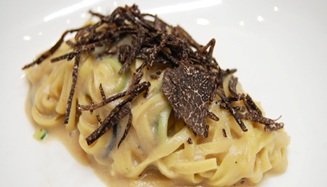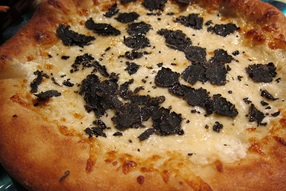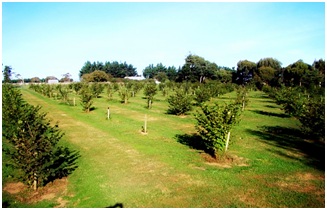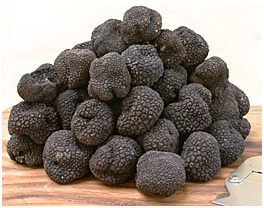Anybody who has set foot in an upscale restaurant in the last 20 years has certainly encountered the delicacy known as the truffle – we mean the ugly mushroom, not the chocolate confection. Cooking with truffles has become a favorite pastime of gourmet chefs everywhere, and they seem determined to use truffles as an ingredient in everything possible, up to and including pasta, pizza, scrambled eggs, and even gelato. And the public is literally eating it up. The reason for all of this? It is the unique flavor of truffle itself. Its rich earthy aroma and flavor has best been described as savory, mossy, pungent, peaty and addictive. Don’t laugh. If you’ve never experienced fresh truffles, you too could become a convert after a few bites of this gnarly little fungus. But fresh truffles are hard to get and they’re expensive unless you’re ready to hop on a private jet to France. They commonly sell for more than $1000 per pound with some going as high as $5000. You’re not likely to find the best quality black Perigord truffles or white Alba truffles on your plate unless you’re paying a hefty price.
 |
 |
Historically grown wild in France and Italy, truffles grow a few inches below the surface of the ground attached to the roots of Oak or Hazelnut trees, and even today they still must be plucked one by one. Current truffle production in France is only about 10% of what it was a century ago due to changes in land use patterns and diminishing market, and today’s French truffle production would only provide about .05 ounce of truffle per French citizen per year. Yes, that’s one twentieth of one ounce per person per year. Statistics show that the last two decades have brought massive growth in the desire for truffles around the world, especially in the United States, so the scientists have been busy finding a remedy. New French techniques now allow truffles to be cultivated successfully by inoculating the roots of the saplings with spores, with harvesting commencing in 5 to 7 years. Because of the burgeoning international demand, plus their high return on investment, truffle orchards are becoming a go-to for investors wanting to get into something with more sizzle than mutual funds or stocks.
Most Profitable Crop That’s Legal
West Coast farmers are planting truffle orchards with fervor. And California winery operators seeking to diversify have also jumped on the truffle bandwagon in a big way in recent years. Climate requirements are similar for grapes and truffles, so their move is an easy one. Compared to grapes, a truffle orchard can produce up to 10 times the revenue per acre while the startup cost is about the same as grapes. But maintenance and labor for truffles are significantly lower and truffle orchards last longer, producing for 40-80 years,  while grapes get replanted every 15 to 20 years. Because an orchard can produce $30,000 to $40,000 in profit per year, some have called truffles the most profitable legal crop in the world. They may be right.
while grapes get replanted every 15 to 20 years. Because an orchard can produce $30,000 to $40,000 in profit per year, some have called truffles the most profitable legal crop in the world. They may be right.
It’s not only winery owners that are getting into the truffle business. The North Carolina tobacco farmers have taken notice and have planted a few hundred acres of truffle orchards as well. There are over 80 truffle orchards in the state with more in the planning stages. Because wine can’t be shipped to many states and tobacco use is on the wane, the planting is receiving accolades from many.
Teenage Truffle Entrepreneur Makes Millions
The opportunities for profits in the truffle boom are not just for those at the top of the i nvestment food chain. Ian Purkayastha is living proof of that. The 19 yr old Arkansas native has found gold in the blackness of the truffle with a business that’s expected to reach $3 million in revenue this year. Born with a love of food, his experience with truffles was a case of love at first bite at age 15 when he first tasted black truffle ravioli. His passion drove him to begin importing truffles from a small French company, selling them directly to chefs through the back doors of their kitchens. His method for success was to just show up with no appointment and a box of truffles under his arm, carefully avoiding any mention that he was only 16. It was a gutsy approach, but it worked, and he eventually developed a website and began shipping out of state. Italian truffle exporter P.A.Q Gubbio found his website, contacted him, and set up a meeting at an upcoming food tradeshow. Without knowing his actual age, they made him their North American representative and he was suddenly on his way. Unbeknownst to him however, was that they had no existing North American clients. He had to start from zero. He left Arkansas and moved to New York, where P.A.Q. Gubbio opened a warehouse. And his success has been over the top since then. In less than three years he has turned his love of truffles into a $1 million business, with this year’s revenues expected to triple that.
nvestment food chain. Ian Purkayastha is living proof of that. The 19 yr old Arkansas native has found gold in the blackness of the truffle with a business that’s expected to reach $3 million in revenue this year. Born with a love of food, his experience with truffles was a case of love at first bite at age 15 when he first tasted black truffle ravioli. His passion drove him to begin importing truffles from a small French company, selling them directly to chefs through the back doors of their kitchens. His method for success was to just show up with no appointment and a box of truffles under his arm, carefully avoiding any mention that he was only 16. It was a gutsy approach, but it worked, and he eventually developed a website and began shipping out of state. Italian truffle exporter P.A.Q Gubbio found his website, contacted him, and set up a meeting at an upcoming food tradeshow. Without knowing his actual age, they made him their North American representative and he was suddenly on his way. Unbeknownst to him however, was that they had no existing North American clients. He had to start from zero. He left Arkansas and moved to New York, where P.A.Q. Gubbio opened a warehouse. And his success has been over the top since then. In less than three years he has turned his love of truffles into a $1 million business, with this year’s revenues expected to triple that.
Truffles at Your Grocery Store?
Truffles are back with a vengeance and their potential economic contribution is staggering. Within 15 years, the Oregon truffle industry is expected to approach their state wine industry’s current revenue of $200 million per year. And North Carolina is poised for success with over 80 orchards planted. But economics aside, the upside is that Americans will soon have access to fresh truffles, possibly even from their local grocer. And feasting on simple food like delicious grilled cheese sandwiches with shaved truffles will be commonplace. When that day comes, the revered truffle will indeed have found a new home.















